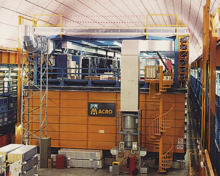
A neutrino is an elementary particle that interacts via the weak interaction and gravity. The neutrino is so named because it is electrically neutral and because its rest mass is so small (-ino) that it was long thought to be zero. The rest mass of the neutrino is much smaller than that of the other known elementary particles. The weak force has a very short range, the gravitational interaction is extremely weak due to the very small mass of the neutrino, and neutrinos do not participate in the electromagnetic interaction or the strong interaction. Thus, neutrinos typically pass through normal matter unimpeded and undetected.
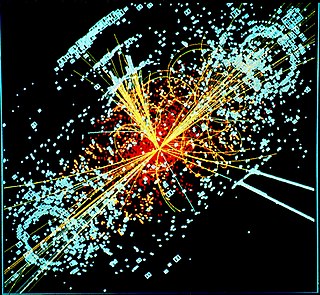
The Sudbury Neutrino Observatory (SNO) was a neutrino observatory located 2100 m underground in Vale's Creighton Mine in Sudbury, Ontario, Canada. The detector was designed to detect solar neutrinos through their interactions with a large tank of heavy water.

The Compact Muon Solenoid (CMS) experiment is one of two large general-purpose particle physics detectors built on the Large Hadron Collider (LHC) at CERN in Switzerland and France. The goal of the CMS experiment is to investigate a wide range of physics, including the search for the Higgs boson, extra dimensions, and particles that could make up dark matter.

Neutrino astronomy is the branch of astronomy that gathers information about astronomical objects by observing and studying neutrinos emitted by them with the help of neutrino detectors in special Earth observatories. It is an emerging field in astroparticle physics providing insights into the high-energy and non-thermal processes in the universe.
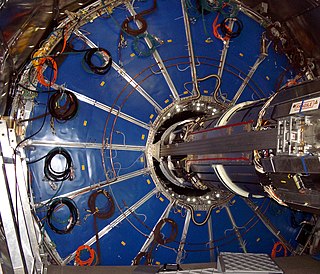
In physics, a time projection chamber (TPC) is a type of particle detector that uses a combination of electric fields and magnetic fields together with a sensitive volume of gas or liquid to perform a three-dimensional reconstruction of a particle trajectory or interaction.
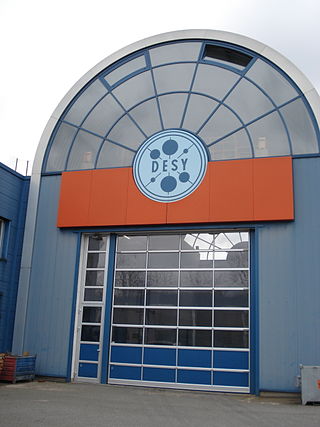
ZEUS was a particle detector at the HERA particle accelerator at the German national laboratory DESY in Hamburg. It began taking data in 1992 and was operated until HERA was decommissioned in June 2007. The scientific collaboration behind ZEUS consisted of about 400 physicists and technicians from 56 institutes in 17 countries.

A neutrino detector is a physics apparatus which is designed to study neutrinos. Because neutrinos only weakly interact with other particles of matter, neutrino detectors must be very large to detect a significant number of neutrinos. Neutrino detectors are often built underground, to isolate the detector from cosmic rays and other background radiation. The field of neutrino astronomy is still very much in its infancy – the only confirmed extraterrestrial sources as of 2018 are the Sun and the supernova 1987A in the nearby Large Magellanic Cloud. Another likely source is the blazar TXS 0506+056 about 3.7 billion light years away. Neutrino observatories will "give astronomers fresh eyes with which to study the universe".
The Mark I, also known as the SLAC-LBL Magnetic Detector, was a particle detector that operated at the interaction point of the SPEAR collider from 1973 to 1977. It was the first 4π detector, i.e. the first detector to uniformly cover as much of the 4π steradians around the interaction point as possible with different types of component particle detectors arranged in layers. This design proved quite successful, and the detector was used in discoveries of the
J/ψ
particle and tau lepton, which both resulted in Nobel prizes. This basic design philosophy continues to be used in all modern collider detectors.
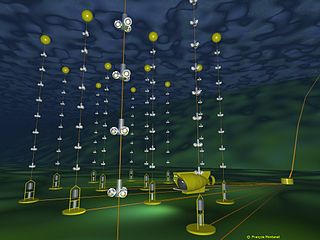
ANTARES is a neutrino detector residing 2.5 km under the Mediterranean Sea off the coast of Toulon, France. It is designed to be used as a directional neutrino telescope to locate and observe neutrino flux from cosmic origins in the direction of the Southern Hemisphere of the Earth, a complement to the South Pole neutrino detector IceCube that detects neutrinos from both hemispheres. The experiment is a recognized CERN experiment (RE6). Other neutrino telescopes designed for use in the nearby area include the Greek NESTOR telescope and the Italian NEMO telescope, which are both in early design stages. The data taking of ANTARES was finished in February 2022, after 16 years of continuous operation.
T2K is a particle physics experiment studying the oscillations of the accelerator neutrinos. The experiment is conducted in Japan by the international cooperation of about 500 physicists and engineers with over 60 research institutions from several countries from Europe, Asia and North America and it is a recognized CERN experiment (RE13). T2K collected data within its first phase of operation from 2010 till 2021. The second phase of data taking is expected to start in 2023 and last until commencement of the successor of T2K – the Hyper-Kamiokande experiment in 2027.
Chooz (French:[ʃo]) was a short baseline neutrino oscillation experiment in Chooz, France. Its major result was setting limits on the neutrino oscillation parameters responsible for changing electron neutrinos into other neutrinos. Specifically, it found that sin2(2θ13) < 0.17 for large δm2 and δm2 > 8×10−4 eV2 for maximal mixing. The results were published in 1999.
The Kamioka Observatory, Institute for Cosmic Ray Research, University of Tokyo is a neutrino and gravitational waves laboratory located underground in the Mozumi mine of the Kamioka Mining and Smelting Co. near the Kamioka section of the city of Hida in Gifu Prefecture, Japan. A set of groundbreaking neutrino experiments have taken place at the observatory over the past two decades. All of the experiments have been very large and have contributed substantially to the advancement of particle physics, in particular to the study of neutrino astronomy and neutrino oscillation.
The Oscillation Project with Emulsion-tRacking Apparatus (OPERA) was an instrument used in a scientific experiment for detecting tau neutrinos from muon neutrino oscillations. The experiment is a collaboration between CERN in Geneva, Switzerland, and the Laboratori Nazionali del Gran Sasso (LNGS) in Gran Sasso, Italy and uses the CERN Neutrinos to Gran Sasso (CNGS) neutrino beam.

Borexino is a deep underground particle physics experiment to study low energy (sub-MeV) solar neutrinos. The detector is the world's most radio-pure liquid scintillator calorimeter and is protected by 3,800 meters of water-equivalent depth. The scintillator is pseudocumene and PPO which is held in place by a thin nylon sphere. It is placed within a stainless steel sphere which holds the photomultiplier tubes (PMTs) used as signal detectors and is shielded by a water tank to protect it against external radiation. Outward pointing PMT's look for any outward facing light flashes to tag incoming cosmic muons that manage to penetrate the overburden of the mountain above. Neutrino energy can be determined through the number of photoelectrons measured in the PMT's. While the position can be determined by extrapolating the difference in arrival times of photons at PMT's throughout the chamber.

The NA62 experiment is a fixed-target particle physics experiment in the North Area of the SPS accelerator at CERN. The experiment was approved in February 2007. Data taking began in 2015, and the experiment is expected to become the first in the world to probe the decays of the charged kaon with probabilities down to 10−12. The experiment's spokesperson is Giuseppe Ruggiero. The collaboration involves 308 participants from 33 institutions and 16 countries around the world.
PERDaix is a novel, small and light weight magnetic spectrometer to measure the charge and mass dependent solar modulation periodically for deeper understanding of cosmic rays. For a better understanding of sources and acceleration of cosmic particles direct measurements of cosmic rays are necessary. Also for a better understanding of the solar modulation which is expected to follow the 22-year solar cycle, time dependent measurements are needed. PERDaix is a newly designed detector which is constructed by the Department of Physics 1b, RWTH Aachen University. Being proposed to the German Space Agency in November 2009 for a participation in the BEXUS Program after a first canceled flight attempt in October 2010 the actual flight took place as a post-BEXUS-campaign flight opportunity in November 2010.
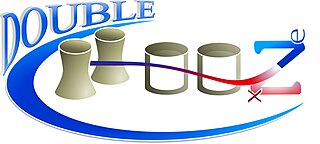
Double Chooz was a short-baseline neutrino oscillation experiment in Chooz, France. Its goal was to measure or set a limit on the θ13 mixing angle, a neutrino oscillation parameter responsible for changing electron neutrinos into other neutrinos. The experiment used the Chooz Nuclear Power Plant reactors as a neutrino source and measured the flux of neutrinos from them. To accomplish this, Double Chooz had a set of two detectors situated 400 meters and 1050 meters from the reactors. Double Chooz was a successor to the Chooz experiment; one of its detectors occupies the same site as its predecessor. Until January 2015 all data had been collected using only the far detector. The near detector was completed in September 2014, after construction delays, and started taking data at the beginning of 2015. Both detectors stopped taking data in late December 2017.

The Accelerator Neutrino Neutron Interaction Experiment (ANNIE) is a proposed water Cherenkov detector experiment designed to examine the nature of neutrino interactions. This experiment will study phenomena like proton decay, and neutrino oscillations, by analyzing neutrino interactions in gadolinium-loaded water and measuring their neutron yield. Neutron Tagging plays an important role in background rejection from atmospheric neutrinos. By implementing early prototypes of LAPPDs, high precision timing is possible. The suggested location for ANNIE is the SciBooNE hall on the Booster Neutrino Beam associated with the MiniBooNE experiment. The neutrino beam originates in Fermilab where The Booster delivers 8 GeV protons to a beryllium target producing secondary pions and kaons. These secondary mesons decay to produce a neutrino beam with an average energy of around 800 MeV. ANNIE will begin installation in the summer of 2015. Phase I of ANNIE, mapping the neutron background, completed in 2017. The detector is being upgraded for full science operation which is expected to begin late 2018.
The diffuse supernova neutrino background(DSNB) is a theoretical population of neutrinos (and anti-neutrinos) cumulatively originating from all core-collapse supernovae events throughout the history of the universe. Though it has not yet been directly detected, the DSNB is theorized to be isotropic and consists of neutrinos with typical energies on the scale of 107 eV. Current detection efforts are limited by the influence of background noise in the search for DSNB neutrinos and are therefore limited to placing limits on the parameters of the DSNB, namely the neutrino flux. Restrictions on these parameters have gotten more strict in recent years, but many researchers are looking to make direct observations in the near future with next generation detectors. The DSNB is not to be confused with the cosmic neutrino background (CNB), which is comprised by relic neutrinos that were produced during the Big Bang and have much lower energies (10−4 to 10−6 eV).
The STEREO experiment investigated the possible oscillation of neutrinos from a nuclear reactor into light so-called sterile neutrinos. It was located at the Institut Laue–Langevin (ILL) in Grenoble, France. The experiment took data from November 2016 to November 2020. The final results of the experiment rejected the hypothesis of a light sterile neutrino.
